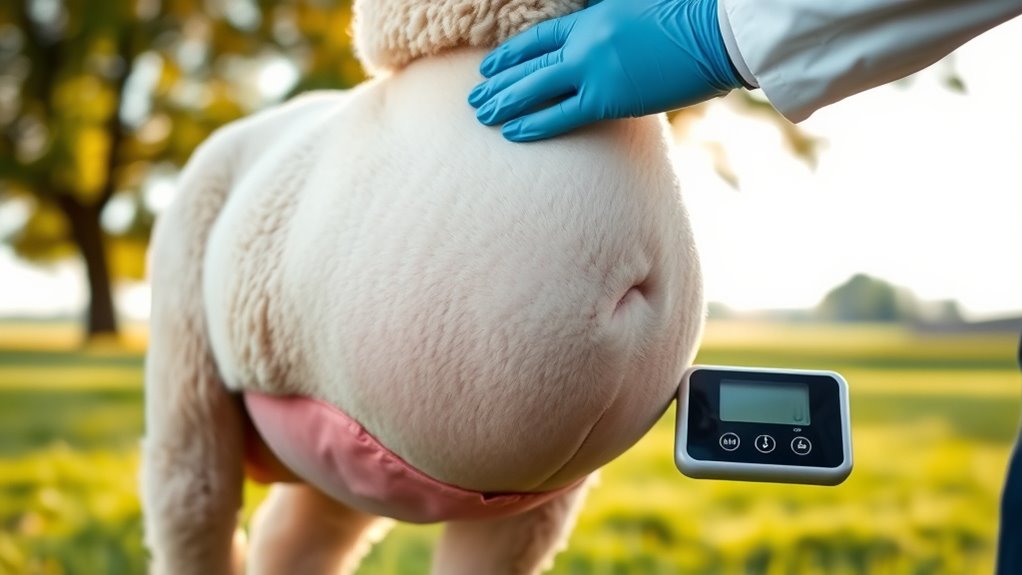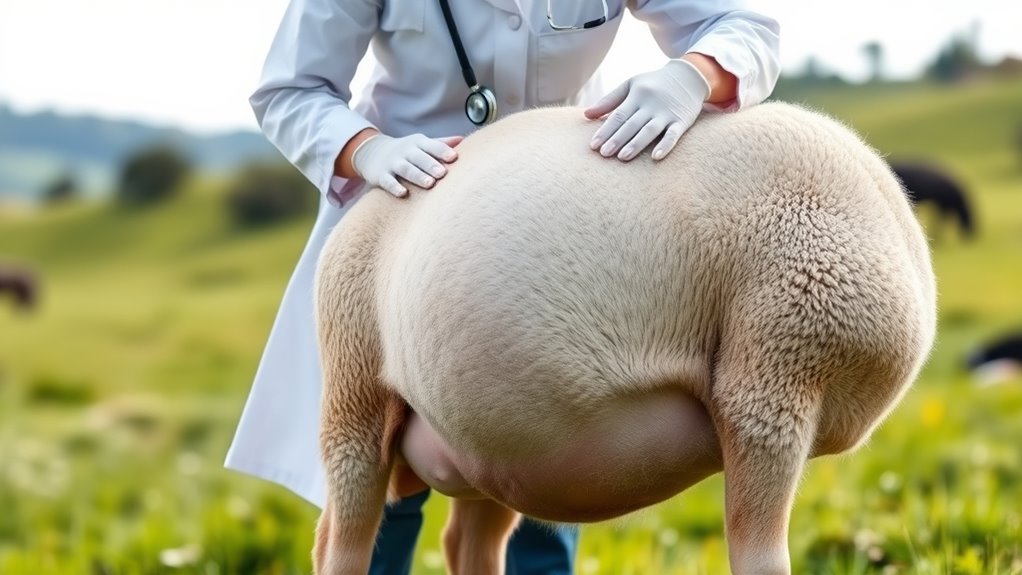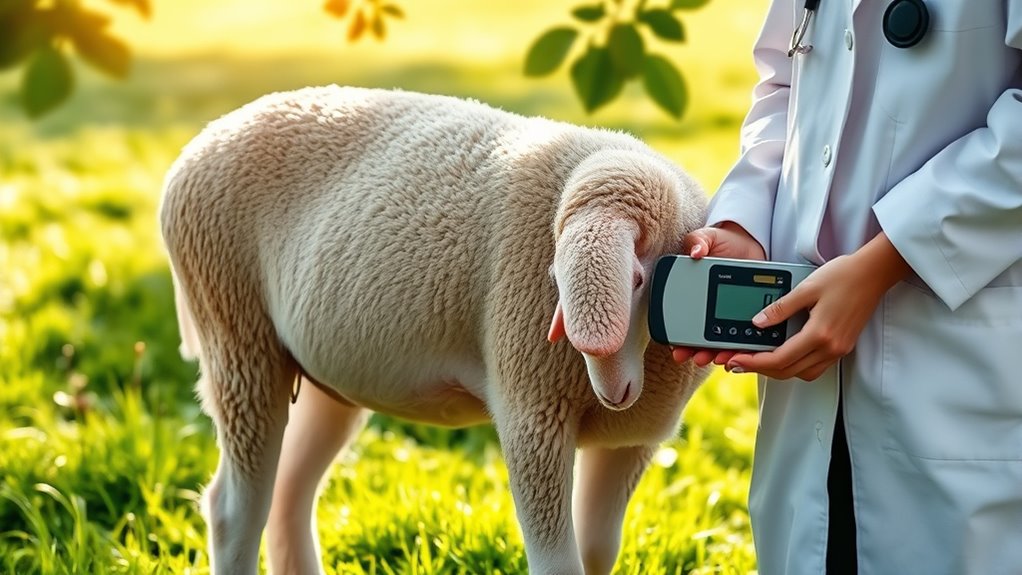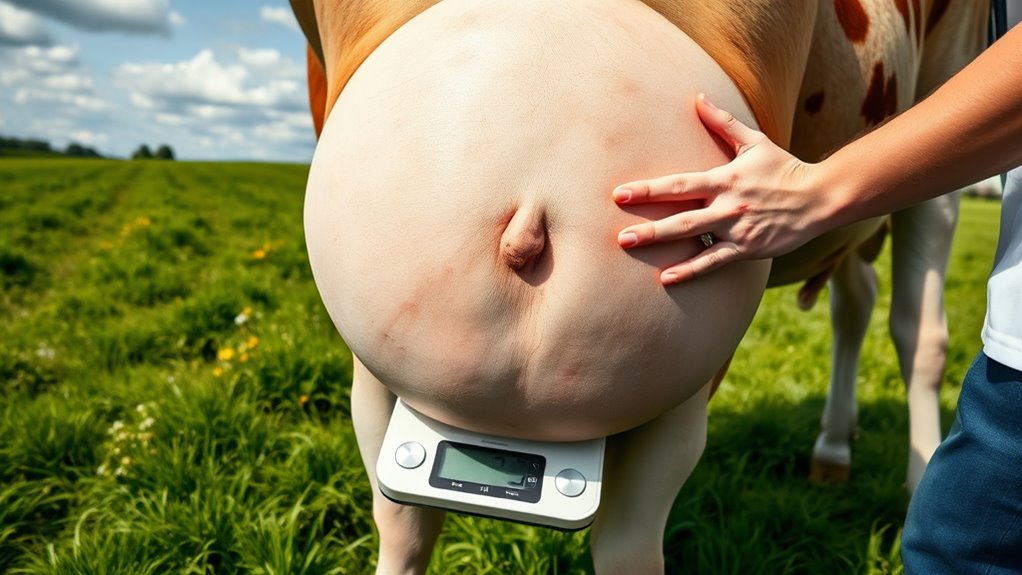Monitoring weight and body condition in pregnant animals is essential for their health and fetal development. Regularly check their weight and assess body condition, focusing on early, mid, and late pregnancy stages. Look for signs of nutritional balance or issues, and record progress over time using charts or apps. Adjust care and nutrition based on these observations to support a healthy pregnancy. Keep going, and you’ll discover how to optimize their well-being during this critical period.
Key Takeaways
- Regularly monitor weight and body condition at key pregnancy stages to detect issues early.
- Use visual inspection, palpation, and scoring to assess fat deposits and overall health.
- Record measurements weekly and body condition scores biweekly for trend analysis.
- Adjust nutrition and management practices based on monitoring data to support fetal development.
- Recognize signs of health problems such as sudden weight loss, abnormal discharges, or behavioral changes.
Importance of Regular Weight Monitoring During Pregnancy

Regular weight monitoring during pregnancy is essential because it helps you track the animal’s health and detect any potential issues early. By keeping a close eye on weight changes, you can identify problems like inadequate weight gain or excessive weight gain, which may signal underlying health concerns. Consistent weighing allows you to adjust nutrition and care plans promptly, ensuring both the mother and developing offspring stay healthy. Sudden weight fluctuations can indicate complications such as infections or metabolic issues, prompting you to seek veterinary advice. Monitoring weight also helps you confirm that the animal is progressing normally through pregnancy stages. Regular weight checks provide a simple yet effective way to maintain ideal health and support a successful pregnancy. Incorporating glycolic acid in skincare routines can improve skin texture and elasticity, which may be beneficial for animals with skin conditions during pregnancy.
Methods for Assessing Body Condition Score

Evaluating the body condition score (BCS) provides a quick and reliable way to assess your animal’s health during pregnancy. To do this effectively, you can use several methods:
- Visual Inspection: Observe the animal’s overall shape, looking for fat deposits over the ribs, pelvis, and spine.
- Palpation: Feel for fat coverage around key areas to gauge fat reserves accurately.
- Rib and Spine Check: Gently run your hands over the ribs and spine to assess their prominence and the surrounding fat layer.
These methods help you gauge whether your animal is underconditioned, ideal, or overconditioned. Proper assessment ensures you can make informed decisions to support a healthy pregnancy and ideal fetal development.
Optimal Timing for Weigh-ins and Body Condition Checks

Timing your weigh-ins and body condition checks is essential for accurate monitoring. You should focus on critical periods during gestation when changes are most significant. Knowing the right stages to assess guarantees you catch issues early and adjust care accordingly. Incorporating nutrient-rich ingredients into your monitoring routine can further support optimal health outcomes for pregnant animals.
Critical Monitoring Periods
When is the best time to monitor pregnant animals to guarantee their health and proper development? The critical monitoring periods are during key phases when changes are most impactful. First, early pregnancy is essential; catching issues early can prevent complications. Second, mid-pregnancy is crucial for evaluating growth and detecting nutritional deficiencies. Lastly, late pregnancy requires close observation to prepare for delivery. Paying attention during these times ensures you can:
- Detect weight loss or gain that signals health concerns
- Adjust nutrition to support fetal development
- Identify early signs of complications before they escalate
Focusing on these periods helps you intervene promptly, reducing risks and promoting a smooth pregnancy. Proper timing in monitoring maximizes the chances of a healthy, successful birth.
Gestation Stage Timing
To guarantee accurate assessments of a pregnant animal’s health, it’s important to schedule weigh-ins and body condition checks at specific stages of gestation. Early in pregnancy, weekly checks help establish a baseline and catch any issues early. During mid-gestation, typically around the halfway point, it’s best to monitor more closely, as weight gain patterns become more apparent. As you approach the final trimester, increase the frequency of checks to ensure the animal maintains ideal body condition and is progressing normally. Timing these assessments correctly allows you to adjust nutrition or management strategies promptly. Remember, consistency is key—checking at similar intervals helps track trends and avoid missing critical health changes. Proper timing ensures your pregnant animal remains healthy and ready for a successful delivery. Utilizing professional equipment can also enhance the accuracy of your measurements and assessments.
Interpreting Changes in Weight and Body Condition

As you monitor your pregnant animals, pay close attention to their weight gain patterns and body condition scores. Sudden or uneven changes can signal potential issues or healthy progress. Understanding these signs helps you make informed decisions to support your animals’ well-being. Regular assessments of body condition can also help in preventing health problems and ensuring optimal development throughout pregnancy.
Weight Gain Patterns
Monitoring weight gain patterns in pregnant animals provides valuable insights into their health and the progress of pregnancy. You’ll notice specific changes that signal everything is on track or if intervention is needed. Proper nutritional balance supports healthy fetal development and overall well-being. Steady, gradual weight increases indicate a healthy pregnancy. Sudden jumps or stalls can suggest issues like nutritional deficiencies or health problems. Consistent weight gain aligns with expected milestones, helping you gauge fetal development. Tracking these patterns helps you identify potential concerns early and ensures your animal remains healthy. If weight gain deviates from the norm, it’s a sign to review diet, monitor for illness, or consult a veterinarian. Understanding these patterns empowers you to support a safe, smooth pregnancy from start to finish.
Body Condition Scores
Tracking body condition scores (BCS) provides a more detailed assessment of an animal’s health and pregnancy progress than weight alone. By evaluating fat cover over specific areas, you can better understand how well your animal is adapting to pregnancy. Changes in BCS can indicate if your animal is gaining weight appropriately or if she’s at risk of being under- or overweight. For instance, a steady increase in BCS suggests healthy fetal development, while a sudden drop may signal nutritional issues or health problems. You should regularly assess BCS, especially during critical pregnancy stages, to adjust feeding or management practices accordingly. Remember, maintaining an ideal BCS supports easier birthing and healthy offspring, making it a crucial part of pregnancy monitoring. Additionally, understanding body condition scoring helps in making informed decisions to optimize maternal and fetal health throughout pregnancy.
Nutritional Strategies Based on Body Condition

Understanding your pregnant animal’s body condition is essential for designing effective nutritional strategies. When she’s in ideal condition, she’s more likely to have a healthy pregnancy and strong offspring. If she’s under-conditioned, she risks complications; if overweight, she may face metabolic issues. To support her, consider these steps:
- Adjust her diet to meet her specific needs, ensuring enough energy and nutrients without overfeeding.
- Provide balanced rations tailored to her condition, emphasizing quality forage and appropriate supplements.
- Monitor her regularly, making timely adjustments as her body condition changes, so she remains healthy and comfortable.
Common Signs of Nutritional Imbalance or Health Issues

Recognizing the signs of nutritional imbalance or health issues early on is essential for maintaining your pregnant animal’s well-being. Watch for sudden weight loss or gain, which can indicate underlying problems. Dull coat, flaky skin, or hair loss may signal deficiencies or health concerns. Changes in appetite—either loss or excessive hunger—are red flags. Lethargy, weakness, or difficulty moving suggest discomfort or illness. Notice any abnormal discharges, swelling, or signs of pain, like vocalization or reluctance to move. Behavioral changes, such as increased agitation or withdrawal, can also indicate distress. Monitoring alimentary health and addressing these signs helps prevent complications, ensuring your animal stays healthy and ready for a successful pregnancy. Regular monitoring and vigilance are key to catching issues early.
Adjusting Care and Management Throughout Gestation

As pregnancy progresses, adjusting your animal’s care and management is crucial to support her changing needs. You’ll need to pay close attention to her body condition, energy levels, and comfort. Here are three key steps to help you adapt effectively:
- Modify feed intake gradually to meet her increasing nutritional demands, ensuring she stays healthy without overfeeding.
- Provide a comfortable, low-stress environment that minimizes physical strain and promotes relaxation.
- Increase monitoring and support during late gestation to catch any issues early, offering prompt care when needed. Maintaining proper body condition is essential for a healthy pregnancy and optimal outcomes.
Record-Keeping and Monitoring Tools for Pregnant Animals

Effective record-keeping and monitoring are essential for tracking the health and progress of pregnant animals. Using the right tools helps you catch issues early and make informed management decisions. Digital apps, spreadsheets, and dedicated charts allow you to log weight, body condition scores, and daily observations easily. Regularly updating these records guarantees you notice trends or concerns promptly. Consider maintaining a table like this to organize your data:
| Data Point | Frequency |
|---|---|
| Weight | Weekly |
| Body Condition Score | Every 2 weeks |
| Behavioral Observations | Daily |
This structured approach keeps you consistent and ready to act, supporting a healthy pregnancy for your animals. Proper documentation ultimately promotes better health outcomes and reduces risks during gestation. Additionally, tracking progress helps you identify patterns that can inform nutritional and healthcare adjustments for optimal fetal development.
Frequently Asked Questions
How Does Breed Influence Weight Gain During Pregnancy?
Your animal’s breed considerably influences its weight gain during pregnancy. Some breeds naturally gain more weight due to their size and genetic traits, while others gain less. For example, larger breeds tend to have more substantial weight increases, supporting fetal development and body reserves. Understanding your animal’s breed helps you tailor your monitoring and nutritional plan, ensuring healthy pregnancy progress and ideal outcomes for both mother and offspring.
Can Environmental Factors Affect Body Condition Assessments?
Yes, environmental factors can affect body condition assessments. For example, extreme weather, limited access to quality forage, or poor shelter can influence an animal’s weight and overall condition. You should consider these factors when evaluating body condition, as they might cause temporary changes that don’t reflect the animal’s true health. Adjust your assessments accordingly, and monitor environmental conditions regularly to get accurate readings.
What Are the Risks of Overfeeding Pregnant Animals?
Overfeeding pregnant animals can lead to obesity, increasing the risk of dystocia, which complicates labor and delivery. It may cause metabolic issues like ketosis or pregnancy toxemia, threatening both the mother and the fetus. Excess weight can also strain joints and cardiovascular systems, reducing mobility and overall health. To avoid these risks, you should carefully monitor their diet, ensuring they receive balanced nutrition without overfeeding.
How Do Pregnancy Stages Impact Nutritional Needs?
Think of pregnancy stages as a journey through different landscapes, each demanding unique nutrients. In early stages, your animal needs less energy, focusing on cell development. As pregnancy progresses, her nutritional needs increase like climbing a hill, requiring more calories, protein, and minerals to support fetal growth. In the final stage, her needs peak, so modify her diet accordingly to ensure she’s well-nourished without overfeeding.
Are There Specific Signs Indicating the Need for Veterinary Intervention?
If your pregnant animal shows signs like sudden weight loss, severe swelling, labored breathing, or persistent lethargy, you should seek veterinary care immediately. Also, watch for unusual discharge, signs of pain, or refusal to eat. These symptoms can indicate complications requiring professional intervention. Prompt veterinary attention helps guarantee the health of both your animal and her unborn offspring, preventing serious issues from developing.
Conclusion
By regularly monitoring your pregnant animals’ weight and body condition, you stay one step ahead—detecting issues early, adjusting care as needed, and supporting healthy pregnancies. Think of it as your steady rhythm, guiding each step with confidence. Consistent checks aren’t just routine; they’re your reassurance that every animal’s journey is on the right track. Stay attentive, keep records, and trust the process—because a healthy pregnancy begins with mindful monitoring.










